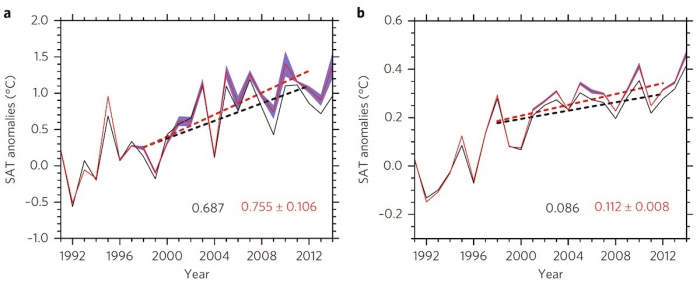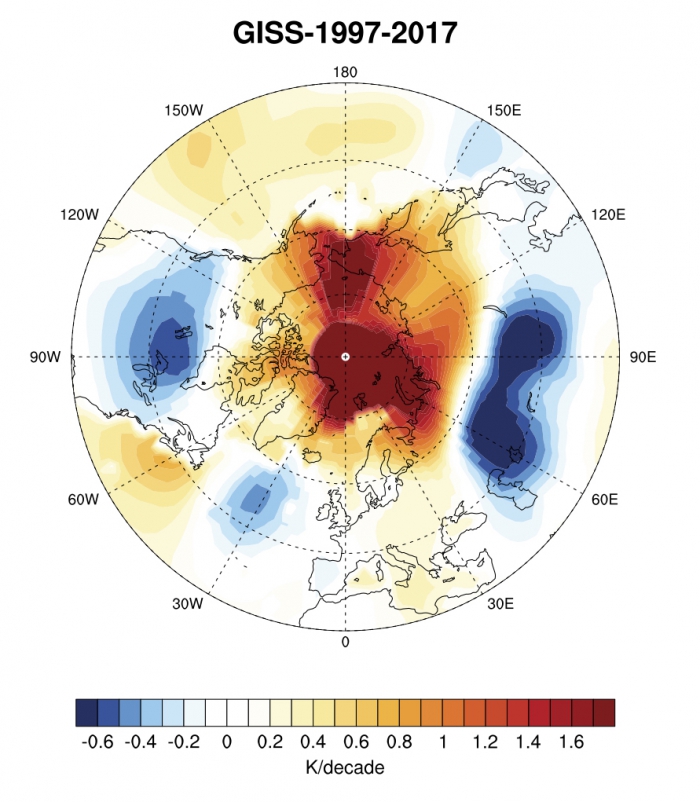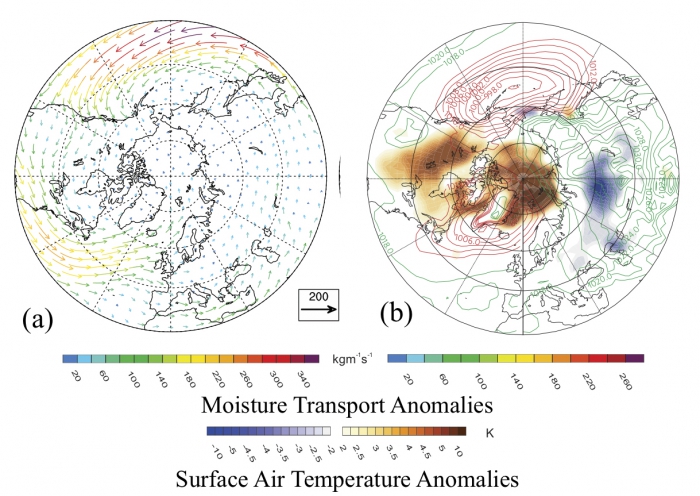By Xiangdong Zhang, International Arctic Research Center and Department of Atmospheric Sciences, University of Alaska Fairbanks
Amplification of Arctic surface air temperature (SAT) increase, at more than twice the rate of average global temperatures since the mid-twentieth century, has been well-recognized (e.g., Serreze et al. 2011; Cohen et al. 2014). Recently, a large number of studies and the Intergovernmental Panel on Climate Change Fifth Assessment Report (IPCC AR5) suggested a hiatus or slow-down of global warming from 1998–2012. However, accurate estimates of Arctic warming have been limited due to sparse observational networks in this remote, harsh, and climatically sensitive area and representation of the Arctic observations in global SAT data sets is problematic. U.S. and Chinese government agencies, including the National Science Foundation, supported recent work by our group of researchers at University of Alaska Fairbanks and Tsinghua University in Beijing, China, that revealed gaps in the spatial and temporal observation datasets analyzed in the earlier global warming studies. Even though various extrapolation approaches were employed in constructing those datasets, the gaps may have caused a biased estimate of contributions of the Arctic warming amplification to the global warming.
Our collaborative groups reconstructed a new global dataset with improved spatial and temporal representation of the Arctic SATs (Huang et al. 2017). In the reconstruction, we employed Arctic-specific observations (i.e., data from the International Arctic Buoy Programme/Polar Exchange at the Sea Surface for the period of 1979–2004; IABP/POLES; Rigor et al. 2000). We also employed the Data Interpolating Empirical Orthogonal Functions (DINEOF) method for reconstruction of the dataset, which is constrained by the available Arctic observations both spatially and temporally.
By analyzing this newly reconstructed global SAT dataset, we found that the Arctic warming amplification has significantly contributed to the global warming trend, causing a continued and even accelerated increase in global mean SAT, rather than a hiatus or slowdown of the trend as earlier studies suggested. The newly estimated rate of global SAT for 1998–2012 is around 0.112℃/decade, instead of 0.05℃/decade from IPCC AR5 (see Figure 1). In extending the analysis time period to the beginning of the twentieth century, we found a global warming rate at 0.091℃/decade from 1900–2014. A comparison with the rate of 0.075℃/decade and 0.089℃/decade from 1900–1998 and 1900–2012, respectively, suggests that global warming has even accelerated. Further analysis indicates that the Arctic SAT has increased at a rate of 0.755℃/decade during 1998–2012, which is more than six times the global average for the same time period. This indicates that the Arctic amplification has also been further enhanced.

Along with the enhanced Arctic warming amplification, the frequency of occurrence of extreme climate and weather events has ostensibly increased across the Northern Hemisphere mid-latitudes, including adverse cold spells, severe heat waves, destructive floods, and persistent droughts (see Figure 2). The coincidence of the changes between the Arctic and mid-latitudes has stimulated broad interest in their possible linkages in the climate community, the general public, media agencies, and decision-makers. There is also a particular interest in changes of occurrence frequency of future extreme events considering the model-projected continuation and acceleration of Arctic warming and associated sea ice loss into the next several decades (e.g., Zhang and Walsh 2006; Wang and Overland 2012; Stroeve et al. 2012). So, it is hypothesized that Arctic warming amplification can influence the mid-latitudes through a number of pathways, including change in the atmospheric circulation, wavier jet stream, and troposphere-stratosphere coupling1, (e.g., a U.S. Climate Variability and Predictability Program (CLIVAR) white paper by Cohen et al. 2018; as well as review papers by Vihma 2014; Cohen et al. 2014; Overland et al. 2016; and Zhang et al. 2018). However, a strong debate emerged and continues in the studies on the topic due to controversial results, especially regarding inconsistencies of atmospheric circulation response to the changed Arctic sea ice.

To understand where consensus has been reached and discrepancies continuously exist, we recently participated in a collaborative effort with international groups to synthesize the results from the latest modeling experiments, especially those from the recent fully coupled2 climate modeling experiments (Screen et al. 2018). The fully coupled climate models unanimously show an Arctic warming amplification and Arctic-mid-latitude linkage in response to Arctic sea ice loss, though there are large diversities in atmosphere-only models. The changes in Northern Hemisphere and Arctic sea level pressure or the surface atmospheric circulation/wind pattern resemble the negative phase of the Arctic Rapid change Pattern (ARP; Zhang et al. 2008), which is characterized by an intensified Siberian High and Aleutian Low and plays a driving role in amplification of Arctic warming and acceleration in sea ice decrease.

The improvement in Arctic SAT representation highlighted above (Huang et al. 2017) further indicates the importance to continue and enhance current efforts to improve the spatial and temporal coverage of Arctic observations and reduce observational and data processing biases. Improved observations are not only crucial for monitoring, assessing, and predicting/projecting Arctic regional climate change, but also global climate change, for example the Arctic-mid-latitude linkages.
Although the recent synthesis, based on the existing fully coupled modeling experiments, exhibits consistency in atmospheric circulation response to sea ice loss (Screen et al. 2018), discrepancies still exist, including signs, strength, and patterns of the simulated temperature anomalies across the models. In particular, physical mechanisms causing the spatially shifted atmospheric circulation structure still remains unknown, though this shift has been identified previously (Zhang et al. 2008) and simulated by the latest fully coupled models. The U.S. CLIVAR Arctic–mid-latitude working group has proposed coordinated modeling experiments, the Polar Amplification Model Intercomparison Project (PAMIP; a U.S. CLIVAR White Paper by Cohen et al. 2018; Smith et al. 2018), which would be an excellent venue to address the need for further study.
For more information about this work, please see “Recently amplified arctic warming has contributed to a continual global warming trend” and “Consistency and discrepancy in the atmospheric response to Arctic sea-ice loss across climate models”.
Author Bio
 Xiangdong Zhang is a professor at the International Arctic Research Center and the Department of Atmospheric Sciences, University of Alaska Fairbanks. His research interests include weather and climate extremes in the present and projected future climate, Arctic-lower latitude interactions, Arctic freshwater and sea ice and their roles in global climate, and development of climate model and improvement of physical treatments.
Xiangdong Zhang is a professor at the International Arctic Research Center and the Department of Atmospheric Sciences, University of Alaska Fairbanks. His research interests include weather and climate extremes in the present and projected future climate, Arctic-lower latitude interactions, Arctic freshwater and sea ice and their roles in global climate, and development of climate model and improvement of physical treatments.
Footnotes
1 Editor's Note: Coupling of the troposphere-stratosphere refers to interaction between the troposphere from the earth's surface to about 3.7–6.2 miles (6–10 km) and the stratosphere just above the troposphere.
2 Editor's Note: Coupling of refers to communication and interchange of information between models.
References
- Cohen, J., J. A. Screen, J. C. Furtado, M. Barlow, D. Whittleston, D. Coumou, J. Francis, K. Dethloff, D. Entekhabi, J. Overland, and J. Jones. 2014. Recent Arctic amplification and extreme mid-latitude weather. Nature Geoscience 7: 627–637. doi:10.1038/ngeo2234.
- Cohen, J., X. Zhang, J. Francis, T. Jung, R. Kwok, J. Overland, P. C. Tayler, S. Lee, F. Laliberte, S. Feldstein, W. Maslowski, G. Henderson, J. Stroeve, D. Coumou, D. Handorf, T. Semmler, T. Ballinger, M. Hell, M. Kretschmer, S. Vavrus, M. Wang, S. Wang, Y. Wu, T. Vihma, U. Bhatt, M. Ionita, H. Linderholm, I. Rigor, C. Routson, D. Singh, M. Wendisch, D. Smith, J. Screen, J. Yoon, Y. Peings, H. Chen, and R. Blackport. 2018. Arctic change and possible influence on mid-latitude climate and weather. US CLIVAR Report 2018–1, 41pp. doi:10.5065/D6TH8KGW.
- Cowtan, K. and R. G. Way. 2014. Coverage bias in the HadCRUT4 temperature series and its impact on recent temperature trends. Quarterly Journal of the Royal Meteorological Society 140: 1935–1944.
- England, M. H., S. McGregor, P. Spence, G. A. Meehl, A. Timmermann, W. Cai, A. S. Gupta, M. J. McPhaden, A. Purich, and A. Santoso. 2014. Recent intensification of wind-driven circulation in the Pacific and the ongoing warming hiatus. Nature Climate Change 4: 222–227.
- Fyfe, J. C., G. A. Meehl, M. H. England, M. E. Mann, B. D. Santer, G. M., Flato, E. Hawkins, N. P. Gillett, S.-P. Xie, Y. Kosaka, and N. C. Swart. 2016. Making sense of the early-2000s warming slowdown. Nature Climate Change 6: 224–228.
- GISTEMP Team. 2018. GISS Surface Temperature Analysis (GISTEMP). NASA Goddard Institute for Space Studies. Dataset accessed 20YY-MM-DD at https://data.giss.nasa.gov/gistemp/.
- Huang, J. X. Zhang, Q. Zhang, Y. Lin, M. Hao, Y. Luo, Z. Zhao, Y. Yao, X. Chen, L. Wang, S. Nie, Y. Yin, Y. Xu, and J. Zhang. 2017. Recently amplified Arctic warming has contributed to a continual global warming trend. Nature Climate Change 7: 875–880. doi:10.1038/s41558-017-0009-5.
- IPCC, Climate Change 2013: The Physical Science Basis. Contribution of Working Group I to The Fifth Assessment Report of the Intergovernmental Panel on Climate Change. Stocker, T. F., Qin, D., Plattner, G.-K., Tignor, M., Allen, S. K., Boschung, J., Nauels, A., Xia, Y., Bex, V. & Midgley, P.M., Eds. Cambridge University Press, Cambridge, United Kingdom and New York, NY, USA, 2013.
- Karl, T. R., A. Arguez, B. Huang, J. H. Lawrimore, J. R. McMahn, M. J. Menne, T., C. Peterson, R. S. Vose, and H.-M. Zhang. 2015. Possible artifacts of data biases in the recent global surface warming hiatus. Science 348: 1469–1472.
- Meehl, G. A., A. Hu, J. Arblaster, J. Fasullo, and K. Trenberth, 2013: Externally forced and internally generated decadal climate variability associated with the interdecadal pacific oscillation. Journal of Climate 26: 7298–7310.
- Overland, J. E., K. Dethloff, J. A. Francis, R. J. Hall, E. Hanna, S.-J. Kim, J. A. Screen, T. G. Shepherd, and T. Vihma. 2016. Nonlinear response of mid-latitude weather to the changing Arctic. Nature Climate Change 6: 992–999. doi:10.1038/nclimate3121.
- Rigor, I. G., R. L. Colony, and S. Martin. 2000. Variations in surface air temperature observations in the Arctic, 1979–97. Journal of Climate 13: 896–914.
- Screen, J. A., C. Deser, D. M. Smith, X. Zhang, R. Blackport, P. J. Kushner, T. Oudar, K. E. McCusker, and L. Sun. 2018. Consistency and discrepancy in the atmospheric response to Arctic sea-ice loss across climate models. Nature Geoscience. doi:10.1038/s41561-018-0059-y.
- Serreze, M. C., and R. G. Barry. 2011. Processes and impacts of Arctic amplification: A research synthesis. Global and Planetary Change 77: 5–96.
- Smith, D., J. A. Screen, C. Deser, J. Cohen, J. C. Fyfe, J. Garcia-Serrano, T. Jung, V. Kattsov, D. Matei, R. Msadek, Y. Peings, M. Sigmond, J. Ukita, J.-H. Yoon, and X. Zhang. 2018. The Polar Amplification Model Intercomparison Project (PAMIP) contribution to CMIP6: Investigating the causes and consequences of polar amplification. Geoscientific Model Development, submitted.
- Stroeve, J. C., V. Kattsov, A. Barrett, M. Serreze, T. Pavlova, M. Holland, and W. N. Meier. 2012. Trends in Arctic sea ice extent from CMIP5, CMIP3 and observations. Geophysical Research Letters 39: L16502. doi:10.1029/2012GL052676.
- Vihma, T. 2014. Effects of Arctic sea ice decline on weather and climate: a review. Surveys in Geophysics 35: 1175–1214.
- Wang, K., T. Zhang, X. Zhang, G. D. Clow, E. E. Jafarov, I. Overeem, V. Romanovsky, X. Peng, and B. Cao. 2017. Continuously Amplified Warming in the Alaskan Arctic: Implications for Estimating Global Warming Hiatus. Geophysical Research Letters 44: 9029–9038. doi:10.1002/2017GL074232.
- Wang, M., and J. E. Overland. 2012. A sea ice free summer Arctic within 30 years: An update from CMIP5 models. Geophysical Research Letters 39: L18501. doi:10.1029/2012GL052868.
- Zhang, X., and J. E. Walsh. 2006. Toward a seasonally ice-covered Arctic Ocean: Scenarios from the IPCC AR4 model simulations. Journal of Climate 19: 1730–1747.
- Zhang, X., A. Sorteberg, J. Zhang, R. Gerdes, and J. C. Comiso. 2008. Recent radical shifts in atmospheric circulations and rapid changes in Arctic climate system. Geophysical Research Letters 35: L22701. doi:10.1029/2008GL035607.
- Zhang, X., J. He, J. Zhang, I. Polaykov, R. Gerdes, J. Inoue, and P. Wu. 2013. Enhanced poleward moisture transport and amplified the northern high-latitude wetting trend. Nature Climate Change 3: 47–51. doi: 10.1038/nclimate1631.
- Zhang, X., J. Thomas, M. Wang, Y. Luo, T. Semmler, and A. Orr, 2018: Preface to the special issue: Towards improving understanding and prediction of Arctic change and its linkage with Eurasian mid-latitude weather and climate. Advances in Atmospheric Sciences 35: 1–4. doi:10.1007/s00376-017-7004-7.
